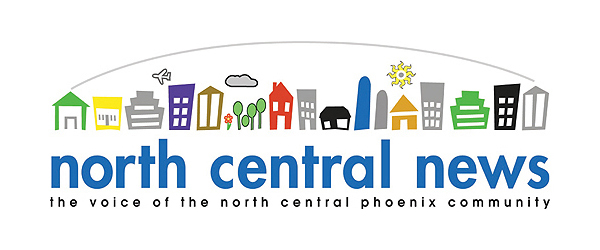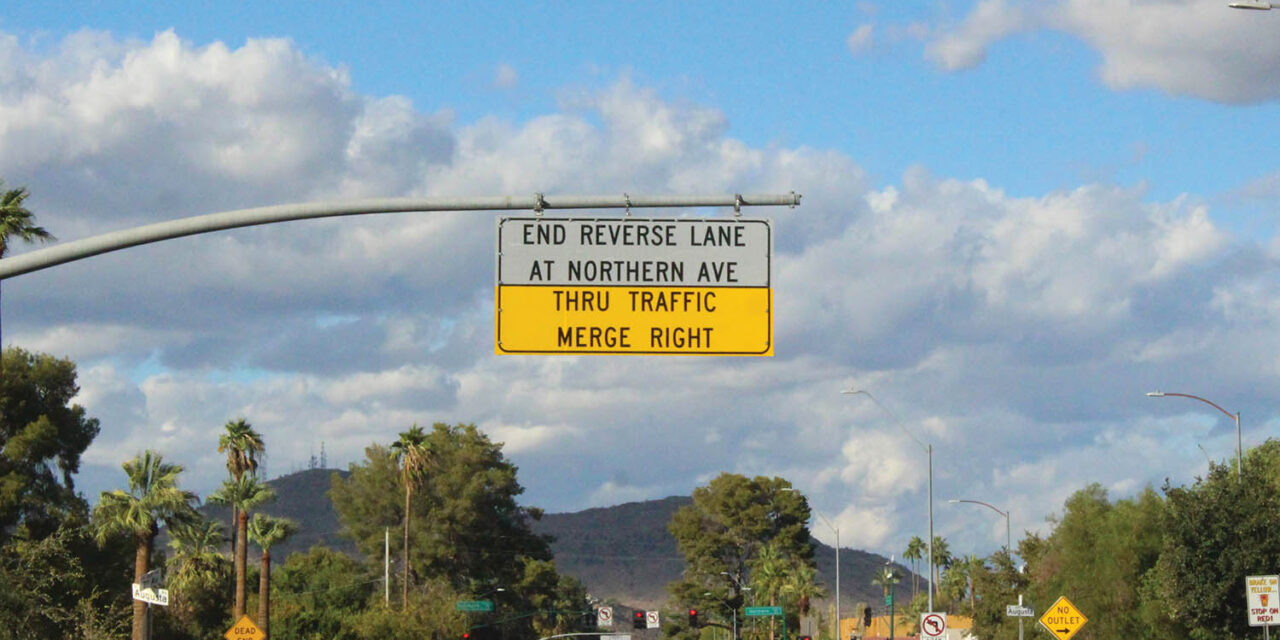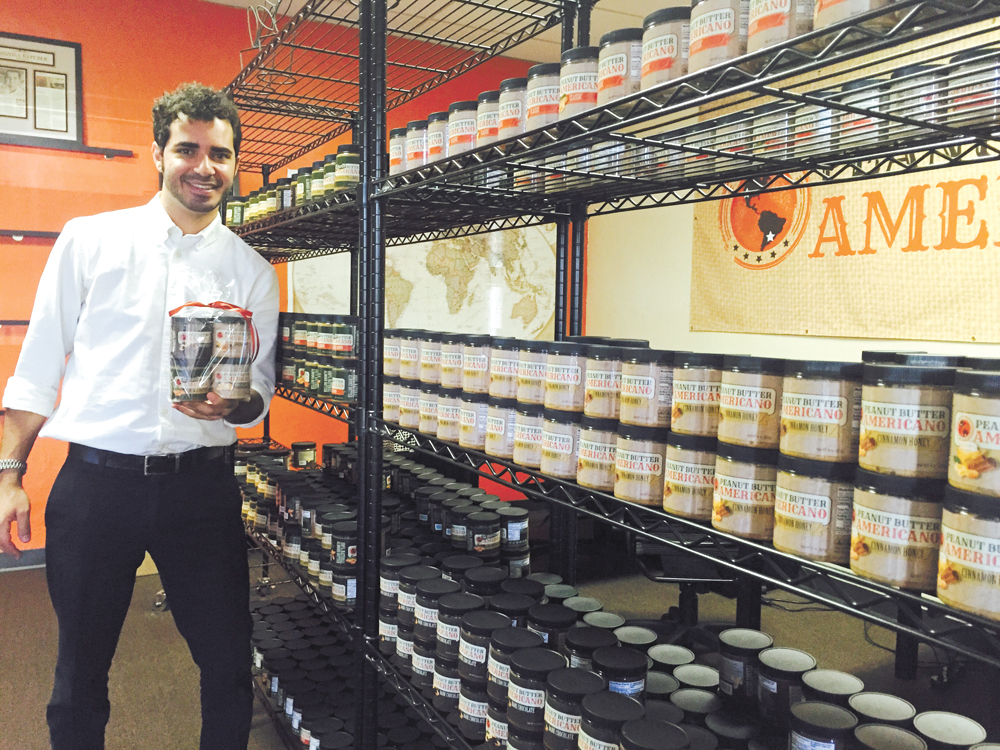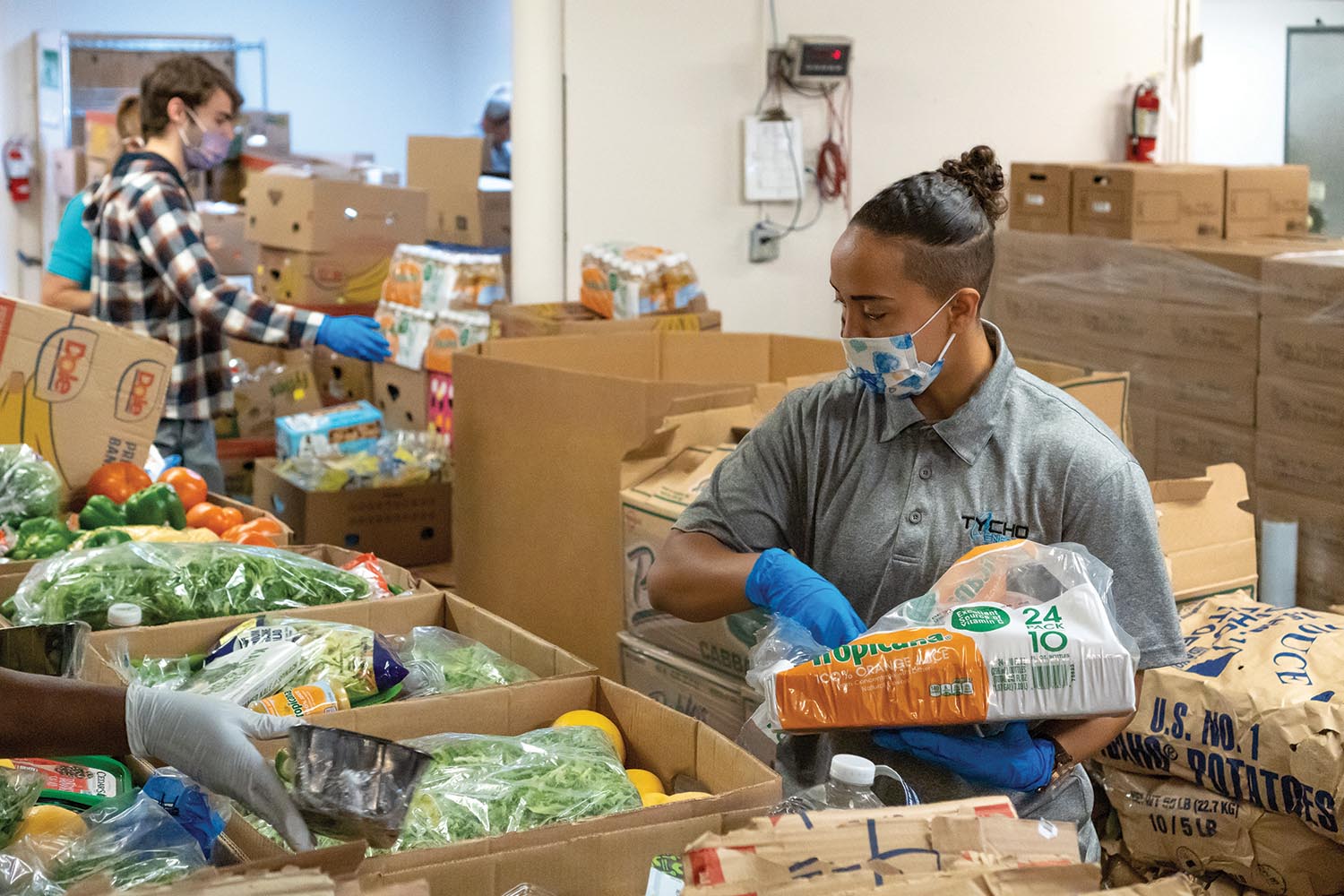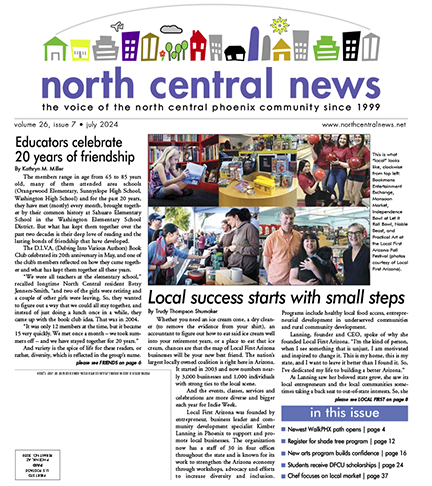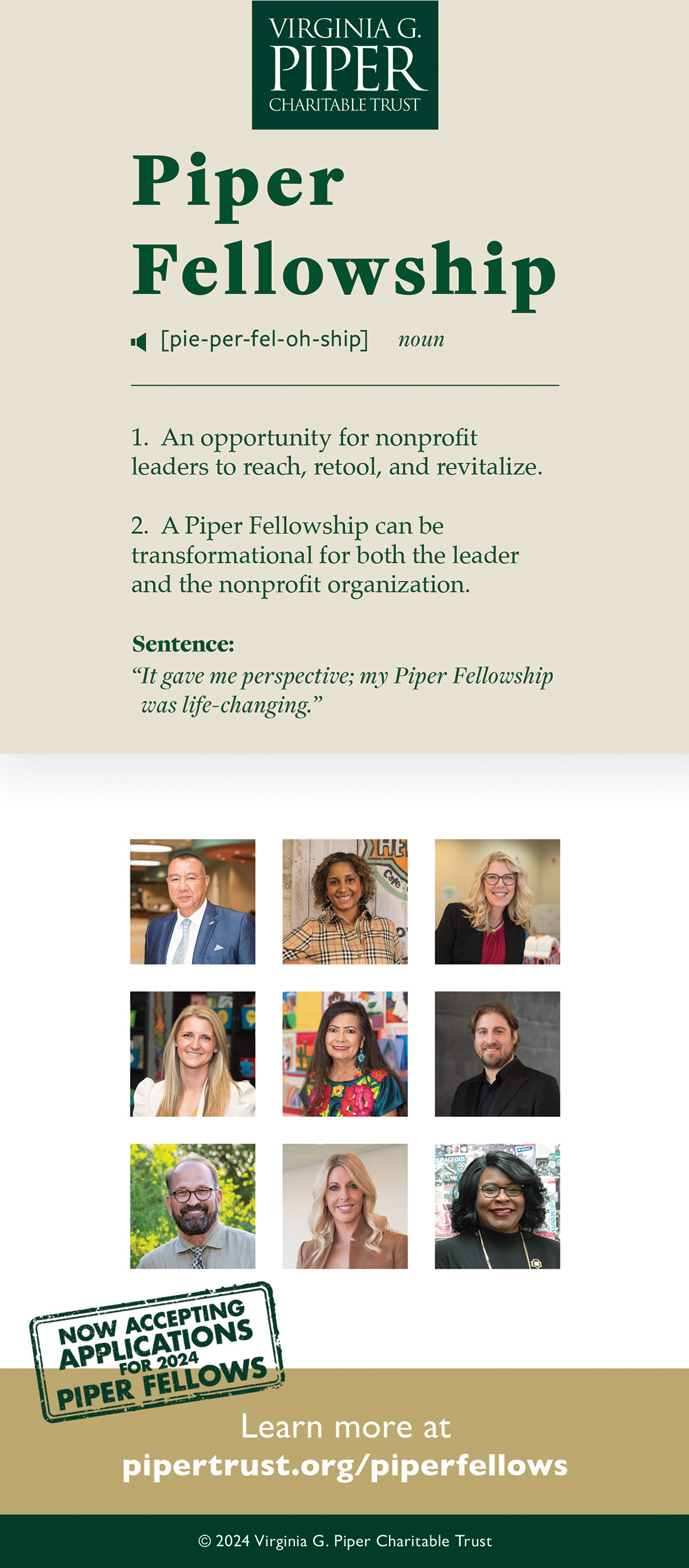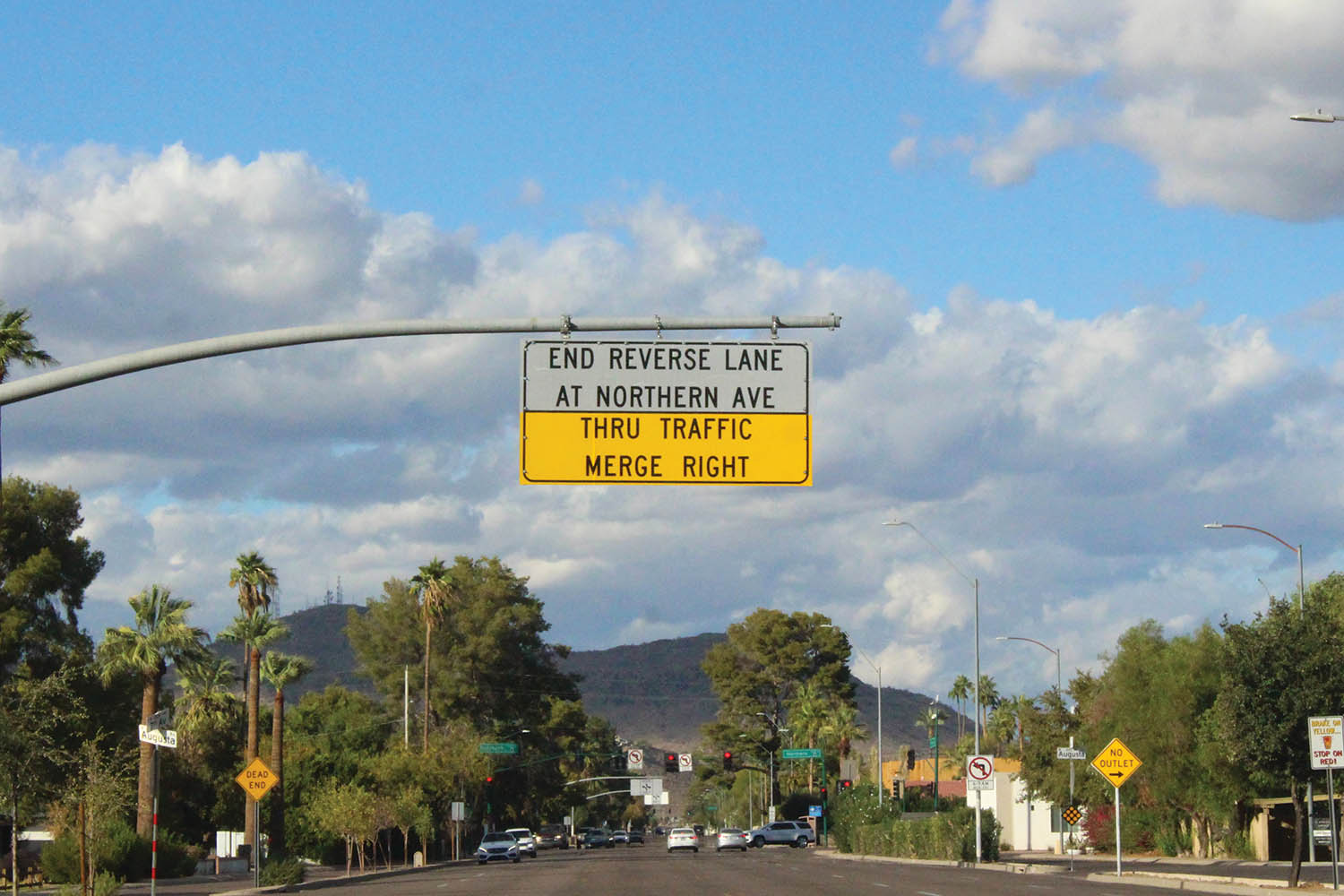
If a growing group of residents have their way, the reverse lanes on 7th Avenue (pictured) and 7th Street will end permanently. The reverse lanes run on 7th Avenue from Northern Avenue to McDowell Road and on 7th Street from Dunlap Avenue to McDowell Road (photo by Kathryn M. Miller).
A petition is making the rounds through North Central’s neighborhoods with a singular goal: get rid of the rush hour reverse lanes on 7th Avenue and 7th Street, also known as the 7s. But not all residents are on board and the city of Phoenix may need some convincing.
The reverse lanes (called “suicide lanes” by many residents) run on 7th Avenue from Northern Avenue to McDowell Road (about 6 miles) and on 7th Street from Dunlap Avenue to McDowell Road (about 7 miles).
The traffic issues impacting the drivers and pedestrians on the 7s are not new — from forcing risky left turns in a lane of traffic and conflicts at intersections when drivers try to make left turns at the wrong time of day to wrong-way encounters and drivers who simply use the center lane to exceed the speed limit to get around traffic during rush hour — nor are collisions.
How it started
“The reverse lanes have been in place on 7th Avenue and 7th Street since 1979 and 1982, respectively,” Gregg Bach, a spokesperson for the Street Transportation Department (Streets), said in an emailed statement. “They were created to address traffic concerns as Phoenix was growing its downtown core. In 1979, the Mayor and City Council challenged staff to come up with transportation system management solutions to the growing traffic congestion problems caused largely by the lack of a regional freeway system. Reverse lanes were proposed as a cost effective solution to address the traffic issues, especially since widening 7th Street and 7th Avenue was not practical.”
A lot has changed in the Valley since that time, including the opening of SR51, which moves traffic south from the northeast part of Phoenix. The original leg opened July 31, 1990, and the last segment, connecting the freeway north to Loop 101 opened to traffic May 31, 2003.
Another change: Valley Metro Light Rail. The initial 20-mile rail line opened Dec. 27, 2008. Two extensions began service by spring 2016 — in particular, the Northwest Extension Phase I, which extended light rail north along 19th Avenue to Dunlap Avenue. Phase II of that extension is slated to open in 2024 and will add 1.6 miles from the light rail station at Dunlap and 19th avenues to Metrocenter’s new elevated transit station northwest of Dunlap and the I-17.
Also in the works in Phoenix is the 35th Avenue Bus Rapid Transit Corridor, which will connect to the Metrocenter transit station, run south down 35th Avenue, then east to the Downtown Central Station.
All three of these transportation improvements serve the purpose of moving residents north and south and connecting to downtown Phoenix and points beyond. Given that, the time would seem ripe to retire the reverse lanes on the 7s. Not so fast, says Streets.
In December 2021, the Phoenix Street Transportation Department finalized a planning and traffic operations study of the reverse traffic lanes on 7th Avenue and 7th Street, and made some recommendations.
Bach’s statement continued, “The study concluded that eliminating the reversible lanes, partially or completely, will create operational delays, increase travel times by more than 40 percent in some segments, and worsen levels of service at signalized intersections that can increase the potential for crashes associated with traffic congestion.
“The study recommends retaining the reversible lanes and to consider improvement strategies such as removal and replacement of static signs, intersection improvements, dynamic lane control and corridor restriping.”
We asked if, given the changes in transportation and even the changes in workplace dynamics since the pandemic, whether the city would consider a new study.
“The department is not considering doing a new study,” Bach responded, “but is considering how the recommendations made in the study that was finalized two years ago can be integrated into the city’s ongoing capital improvement plan.” A timeline for when any changes would be made has not been identified.
How it’s going
The petition, which hit Change.org Nov. 1 with a goal of 1,500 signatures, was addressed to Phoenix decision makers, specifically the Phoenix mayor, eight City Council members, Phoenix City Manager and the interim Streets director (a new director, Joe Brown, came on board Nov. 20 after the October retirement from the city of Kini Knudson).
The crux of the petition is that the lanes are too dangerous, hurt connectivity and have negatively impacted neighborhoods and businesses, reading in part, “Killing the reverse rush hour lanes will help businesses along 7th Street and 7th Avenue (many of which are very hard, if not impossible to access during key portions of the day) will make it a more enjoyable experience to drive, walk, and bike on the 7’s, and will make our communities safer. We ask that you immediately end the rush hour reverse lanes for these reasons, and keep the middle lane as a turn lane only throughout all times of the day.”
The petition was closing in on 2,200 signatures by mid-November, but not everyone is convinced that getting rid of the lanes is prudent, and point to 2021 study’s findings.
“As much as some people don’t like the reverse lanes, they really do move large volumes of traffic,” said Mary Crozier, president of the North Central Phoenix Homeowners Association.
But that doesn’t mean the lanes are perfect, and Crozier agrees that they can be dangerous. She added, “We could do just a few things and make these reverse lanes safer, better equipped for businesses and for drivers and pedestrians, and it wouldn’t take an awful lot. I don’t know why the city has dragged their feet on that, but something as simple as putting a digital sign with a big red ‘x’ and a big green check — that’s a universal language for all drivers that says drive in this lane and not that lane.”
One concern that Crozier and others have expressed is that eliminating the reverse lanes will create more congestion — something that the 2021 study suggests — which may move traffic off of the 7s and into neighborhoods, which has its own dangers.
“The study is flawed,” says Ed Hermes, who helped write the petition and is the president of the Carnation Association of Neighbors, which is bounded by 7th Avenue’s Melrose District. “It doesn’t look at the impact on communities, it didn’t look at the impact on businesses. So, the study was just flawed from the get-go.
“It looked at getting people through our community and not really being in our community and enjoying our community,” Hermes added. “That was the mindset of the council when they passed it. They didn’t care about our communities. They just wanted to get people through them. And we’re not just a place to rush through. Here in Midtown and Uptown Phoenix, we’re a destination. But we really can’t see our potential fulfilled, especially in the Melrose District, until we get rid of these reverse lanes.”
Hermes adds, “It’s a really cool area with small businesses. We don’t have chain restaurants and things like that in the Melrose area. These are genuinely small businesses and to a person, these business owners we talked to say that the reverse lanes are hurting their business. You only hear those stories enough before you say, ‘We need to do something about it’.”
The next steps for the group behind the petition are to continue to build community support. They are garnering resolutions that support the petition from other area neighborhood associations in and around the 7s, and continuing to get businesses to join the movement. They are also considering raising funds for their own study that will look deeper into how the reverse lanes impact the surrounding community. From there, they hope to present their case to the City Council.
About that 2021 study
Beyond the criticism that the study focuses too much on travel time rather than other negative impacts on neighborhoods and businesses is the fact that three of the five cities cited in the study have since retired or are reviewing their own reverse lanes, citing hazardous conditions for drivers and pedestrians, as well as the desire for more walkable, bikeable and accessible areas. Those cities are Washington D.C., Charlotte, NC and Louisville, KY.
In D.C., the Connecticut Avenue Multimodal Safety Improvement Project, initiated in Dec. 2019, concluded with three goals in place: Reduce fatalities and serious injuries across all modes; Consider a Protected Bicycle Facility/Additional Mobility Options for the corridor; and Assess the feasibility of removing reversible lane operations along Connecticut Avenue NW. The reversible lane operations were subsequently discontinued in summer 2022 and the speed limit was also reduced.
In Charlotte, a mile-long portion of reversible lane system on their 7th Street was under review in October 2022. A 90-day study was conducted and the reverse lanes were closed to study the impact with a goal of finding a solution to traffic troubles in the area. The reverse lanes on Tyvola Road, which according to the Phoenix study were designed to bring traffic to and from the Charlotte Coliseum, no longer exist. The Coliseum was demolished in 2007, and while Google Street view showed some static signs still in place in June 2012, there was no remnant by May 2014 in the area near the former Coliseum entrance.
In Louisville, after the efforts of the nonprofit Friends of Bardstown Road, working in conjunction with two city council members and other stakeholders, The Bardstown Road Safety Study was released in December 2018 and resulted in the removal of overhead reversible lane assignment lights and signs and added designated turn lanes at signalized intersections, as well as the addition of curb extensions and crosswalks to address safety concerns, among other changes. According to an opinion piece by the Friends published in the Courier Journal, “The redesign will make the street safer, more accessible and more beautiful. The redesign will remake the road into a street for people,” and create “a road that is calmer, safer,” and “make an already inviting place more so.”
And that is what many Phoenix residents, in the Melrose District in particular, are asking for with the current petition: safer, calmer, walkable streets that place focus on the community rather than the commute.
To read the city’s report and learn more about the history of reverse lanes, visit www.phoenix.gov/streets/projects/7th-street-and-7th-avenue-reverse-lanes. To read the petition to end the rush hour reverse lanes on the 7s and learn more about the residents organizing the push, visit www.endreverselanes.com.
